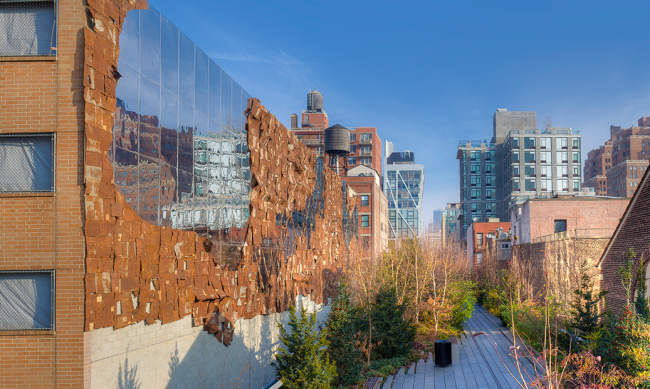
Design has long been seen largely as a matter of appearance, with public design being no exemption.
The recent trend in public design, however, reflects a call for change among designers, says professor Ko Young-lan of Hansung University.
“In a way, public design is an act of reflection by designers on what they have been doing. Instead of going top-down, asking the public to accept what we have designed, we are moving toward finding their needs and drawing out user-centered experiences,” said Ko, who headed the panel of judges for the 2013 Korean Public Design Awards.
She said that the essence of public design was democracy ― the designers and locals as well as all of those involved get the same rights and responsibilities in the project.
“It always has to come from the locals and their satisfaction ― the actual users and possibly those responsible for the maintenance in the future,” she said.
“Sometimes it can take a long time, in contrast to the ‘efficiency’ that Koreans prefer. The High Line project took years to reach an agreement and I suppose it will be the same if we bring the model to Korea. In a way, the majority of public art projects involving locals in Korea do not completely match the ideal concept of public design,” Ko said.
Ko sees the High Line project in Manhattan, New York, as a good example of public design. The public park was built in 1999 on a historic freight rail line elevated above the streets on Manhattan’s West Side by community residents who fought for the High Line’s preservation and transformation at a time when the historic structure was under threat of demolition.
Artists produce pieces inspired by the area while residents hold various events to foster community spirit. Friends of the High Line, the organizers of the project composed of residents, raise funds to support more than 90 percent of the park’s annual operation budget.
“What we really need at this point is maybe to ease our obsession with the term ‘public.’ There is a blurred line, almost no clear line, between what people call public and private design,” she said. “Sticking to the very basic principles of design ― detecting a problem and finding a solution with a touch of design ― will do.”
By Bae Ji-sook (baejisook@heraldcorp.com)
The recent trend in public design, however, reflects a call for change among designers, says professor Ko Young-lan of Hansung University.
“In a way, public design is an act of reflection by designers on what they have been doing. Instead of going top-down, asking the public to accept what we have designed, we are moving toward finding their needs and drawing out user-centered experiences,” said Ko, who headed the panel of judges for the 2013 Korean Public Design Awards.
She said that the essence of public design was democracy ― the designers and locals as well as all of those involved get the same rights and responsibilities in the project.
“It always has to come from the locals and their satisfaction ― the actual users and possibly those responsible for the maintenance in the future,” she said.
“Sometimes it can take a long time, in contrast to the ‘efficiency’ that Koreans prefer. The High Line project took years to reach an agreement and I suppose it will be the same if we bring the model to Korea. In a way, the majority of public art projects involving locals in Korea do not completely match the ideal concept of public design,” Ko said.
Ko sees the High Line project in Manhattan, New York, as a good example of public design. The public park was built in 1999 on a historic freight rail line elevated above the streets on Manhattan’s West Side by community residents who fought for the High Line’s preservation and transformation at a time when the historic structure was under threat of demolition.
Artists produce pieces inspired by the area while residents hold various events to foster community spirit. Friends of the High Line, the organizers of the project composed of residents, raise funds to support more than 90 percent of the park’s annual operation budget.
“What we really need at this point is maybe to ease our obsession with the term ‘public.’ There is a blurred line, almost no clear line, between what people call public and private design,” she said. “Sticking to the very basic principles of design ― detecting a problem and finding a solution with a touch of design ― will do.”
By Bae Ji-sook (baejisook@heraldcorp.com)
-
Articles by Korea Herald


![[AtoZ into Korean mind] Humor in Korea: Navigating the line between what's funny and not](http://res.heraldm.com/phpwas/restmb_idxmake.php?idx=644&simg=/content/image/2024/04/22/20240422050642_0.jpg&u=)
![[Exclusive] Korean military set to ban iPhones over 'security' concerns](http://res.heraldm.com/phpwas/restmb_idxmake.php?idx=644&simg=/content/image/2024/04/23/20240423050599_0.jpg&u=20240423183955)



![[Graphic News] 77% of young Koreans still financially dependent](http://res.heraldm.com/phpwas/restmb_idxmake.php?idx=644&simg=/content/image/2024/04/22/20240422050762_0.gif&u=)
![[Herald Interview] Why Toss invited hackers to penetrate its system](http://res.heraldm.com/phpwas/restmb_idxmake.php?idx=644&simg=/content/image/2024/04/22/20240422050569_0.jpg&u=20240422150649)






![[Exclusive] Korean military to ban iPhones over security issues](http://res.heraldm.com/phpwas/restmb_idxmake.php?idx=652&simg=/content/image/2024/04/23/20240423050599_0.jpg&u=20240423183955)



![[Today’s K-pop] Ateez confirms US tour details](http://res.heraldm.com/phpwas/restmb_idxmake.php?idx=642&simg=/content/image/2024/04/23/20240423050700_0.jpg&u=)